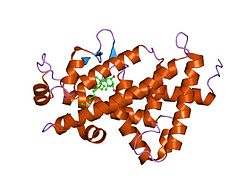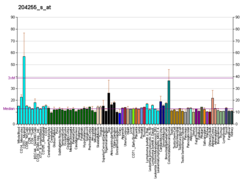Receptor vitamina D
Receptor kalcitriola – poznat i kao receptor vitamina D (VDR) i NR1 I 1 (potporodica nuklearnih receptora 1, grupa I, član 1) – je član porodice nuklearnih receptora transkripcijskih faktora.[5] Nakon aktivacije vitamina D, VDR formira heterodimer sa retinoidnim X receptorom i veže sa elementima hormonskog odgovora na DNK. To rezultira u ispoljavanju ili transrepresiji specifičnih genskih proizvoda. VDR-i ne reguliraju samo transkripcijski odgovor, već su uključeni i u posttranskripcijske mehanizme koje usmjerava mikroRNK.[6] Kod ljudi, receptor vitamina D je kodiran genom VDR.[7]
Glukokortikoidi su poznati po smanjivanju ekspresije VDR, što se ispoljava u većini tkiva, a u probavnom traktu regulira transport kalcija, željeza i ostalih minerala.[8]
Funkcija
[uredi | uredi izvor]Sinteza receptora vitamina vitamina D3 je genetički kontrolrana. Ovaj receptor istovremeno funkcionira i kao sekundarna žučna i lithoholna kiselina. Receptor pripada porodici of trans-activnih transcripcijskih regulatornih factora i pokazuju sličnost sekvence sa receptorima steroidnih i tiroidnih hormona.[9]
Nizvodni ciljevi ovog nuklearnog receptora hormona su uključeni uglavnom u metabolizam minerala, iako receptor regulira i niz drugih metaboličkih puteva, kao što su oni koji su uključeni u imuni odgovor i rak.[10]
Mutacije u ovom genu su povezane sa rezistentnošću rahitisa na vitamin D, tip II. Jednostruki nuklearni polimorfizam u inicijacijskom kodonu rezultira izmijenjenom translacijom startnog mjesta, tri kodona nizvodno. Alternativna prerada RNK se ispoljava u više transkribiranih varijanti koje kodiraju isti protein.[11]
Receptor vitamina D ima važnu ulogu u reguliranju ciklusa rasta dlake. Gubitak gena VDR je, kod ekperimentalnih životinja, povezan sa gubitkom dlake[12] |slušnog ježaExperimentalna proučavanja pokazuju da neligandirani VDR stupa u interakciju sa ragulacijskom ciljnom regijom gena cWnt (wnt signalni put) i slušnog ježa i pokreće ovaj put tokom postnatalnog ciklusa rasta dlake.[13] Ove studije su otkrile nove akcije neligandskih VDR u reguliranju post-morfogenog ciklusa dlake.
Interakcije
[uredi | uredi izvor]Kalcitriolski receptor pokazuje interakcije protein-proteinrotein-protein sa
Također pogledajte
[uredi | uredi izvor]Reference
[uredi | uredi izvor]- ^ a b c GRCh38: Ensembl release 89: ENSG00000111424 - Ensembl, maj 2017
- ^ a b c GRCm38: Ensembl release 89: ENSMUSG00000022479 - Ensembl, maj 2017
- ^ "Human PubMed Reference:". National Center for Biotechnology Information, U.S. National Library of Medicine.
- ^ "Mouse PubMed Reference:". National Center for Biotechnology Information, U.S. National Library of Medicine.
- ^ Moore DD, Kato S, Xie W, Mangelsdorf DJ, Schmidt DR, Xiao R, Kliewer SA (decembar 2006). "International Union of Pharmacology. LXII. The NR1H and NR1I receptors: constitutive androstane receptor, pregnene X receptor, farnesoid X receptor alpha, farnesoid X receptor beta, liver X receptor alpha, liver X receptor beta, and vitamin D receptor". Pharmacol. Rev. 58 (4): 742–59. doi:10.1124/pr.58.4.6. PMID 17132852.CS1 održavanje: upotreba parametra authors (link)
- ^ Lisse TS, Chun RF, Rieger S, Adams JS, Hewison M (juni 2013). "Vitamin D activation of functionally distinct regulatory miRNAs in primary human osteoblasts". J Bone Miner Res. 28 (6): 1478–14788. doi:10.1002/jbmr.1882. PMID 23362149.CS1 održavanje: upotreba parametra authors (link)
- ^ Szpirer J, Szpirer C, Riviere M, Levan G, Marynen P, Cassiman JJ, Wiese R, DeLuca HF (septembar 1991). "The Sp1 transcription factor gene (SP1) and the 1,25-dihydroxyvitamin D3 receptor gene (VDR) are colocalized on human chromosome arm 12q and rat chromosome 7". Genomics. 11 (1): 168–73. doi:10.1016/0888-7543(91)90114-T. PMID 1662663.CS1 održavanje: upotreba parametra authors (link)
- ^ Fleet JC, Schoch RD (august 2010). "Molecular Mechanisms for Regulation of Intestinal Calcium Absorption by Vitamin D and Other Factors". Crit Rev Clin Lab Sci. 47 (4): 181–195. doi:10.3109/10408363.2010.536429. PMID 21182397.CS1 održavanje: upotreba parametra authors (link)
- ^ Germain P, Staels B, Dacquet C, Spedding M, Laudet V (decembar 2006). "Overview of nomenclature of nuclear receptors". Pharmacol. Rev. 58 (4): 685–704. doi:10.1124/pr.58.4.2. PMID 17132848.CS1 održavanje: upotreba parametra authors (link)
- ^ Adorini L, Daniel KC, Penna G (2006). "Vitamin D receptor agonists, cancer and the immune system: an intricate relationship". Curr Top Med Chem. 6 (12): 1297–301. doi:10.2174/156802606777864890. PMID 16848743.CS1 održavanje: upotreba parametra authors (link)
- ^ "Entrez Gene: VDR vitamin D (1,25- dihydroxyvitamin D3) receptor".
- ^ Luderer HF, Demay MB (juli 2010). "The vitamin D receptor, the skin and stem cells". J. Steroid Biochem. Mol. Biol. 121 (1–2): 314–6. doi:10.1016/j.jsbmb.2010.01.015. PMID 20138991.CS1 održavanje: upotreba parametra authors (link)
- ^ Lisse TS, Saini V, Zhao H, Luderer HF, Gori F, Demay MB (septembar 2014). "The Vitamin D Receptor Is Required for Activation of cWnt and Hedgehog Signaling in Keratinocytes". Mol. Endocrinol. 28 (10): 1698–1706. doi:10.1210/me.2014-1043. PMID 25180455.CS1 održavanje: upotreba parametra authors (link)
- ^ Guzey M, Takayama S, Reed JC (decembar 2000). "BAG1L enhances trans-activation function of the vitamin D receptor". J. Biol. Chem. 275 (52): 40749–56. doi:10.1074/jbc.M004977200. PMID 10967105.CS1 održavanje: upotreba parametra authors (link)
- ^ a b c d e Kitagawa H, Fujiki R, Yoshimura K, Mezaki Y, Uematsu Y, Matsui D, Ogawa S, Unno K, Okubo M, Tokita A, Nakagawa T, Ito T, Ishimi Y, Nagasawa H, Matsumoto T, Yanagisawa J, Kato S (juni 2003). "The chromatin-remodeling complex WINAC targets a nuclear receptor to promoters and is impaired in Williams syndrome". Cell. 113 (7): 905–17. doi:10.1016/S0092-8674(03)00436-7. PMID 12837248.CS1 održavanje: upotreba parametra authors (link)
- ^ Zhao G, Simpson RU (2010). "Membrane Localization, Caveolin-3 Association and Rapid Actions of Vitamin D Receptor in Cardiac Myocytes". Steroids. 75 (8–9): 555–9. doi:10.1016/j.steroids.2009.12.001. PMC 2885558. PMID 20015453.CS1 održavanje: upotreba parametra authors (link)
- ^ a b Ito M, Yuan CX, Malik S, Gu W, Fondell JD, Yamamura S, Fu ZY, Zhang X, Qin J, Roeder RG (mart 1999). "Identity between TRAP and SMCC complexes indicates novel pathways for the function of nuclear receptors and diverse mammalian activators". Mol. Cell. 3 (3): 361–70. doi:10.1016/S1097-2765(00)80463-3. PMID 10198638.CS1 održavanje: upotreba parametra authors (link)
- ^ a b Tagami T, Lutz WH, Kumar R, Jameson JL (decembar 1998). "The interaction of the vitamin D receptor with nuclear receptor corepressors and coactivators". Biochem. Biophys. Res. Commun. 253 (2): 358–63. doi:10.1006/bbrc.1998.9799. PMID 9878542.CS1 održavanje: upotreba parametra authors (link)
- ^ a b c d Puccetti E, Obradovic D, Beissert T, Bianchini A, Washburn B, Chiaradonna F, Boehrer S, Hoelzer D, Ottmann OG, Pelicci PG, Nervi C, Ruthardt M (decembar 2002). "AML-associated translocation products block vitamin D(3)-induced differentiation by sequestering the vitamin D(3) receptor". Cancer Res. 62 (23): 7050–8. PMID 12460926.CS1 održavanje: upotreba parametra authors (link)
- ^ Herdick M, Steinmeyer A, Carlberg C (juni 2000). "Antagonistic action of a 25-carboxylic ester analogue of 1alpha, 25-dihydroxyvitamin D3 is mediated by a lack of ligand-induced vitamin D receptor interaction with coactivators". J. Biol. Chem. 275 (22): 16506–12. doi:10.1074/jbc.M910000199. PMID 10748178.CS1 održavanje: upotreba parametra authors (link)
- ^ a b c Zhang C, Baudino TA, Dowd DR, Tokumaru H, Wang W, MacDonald PN (novembar 2001). "Ternary complexes and cooperative interplay between NCoA-62/Ski-interacting protein and steroid receptor coactivators in vitamin D receptor-mediated transcription". J. Biol. Chem. 276 (44): 40614–20. doi:10.1074/jbc.M106263200. PMID 11514567.CS1 održavanje: upotreba parametra authors (link)
- ^ He B, Wilson EM (mart 2003). "Electrostatic Modulation in Steroid Receptor Recruitment of LXXLL and FXXLF Motifs". Mol. Cell. Biol. 23 (6): 2135–50. doi:10.1128/MCB.23.6.2135-2150.2003. PMC 149467. PMID 12612084.CS1 održavanje: upotreba parametra authors (link)
- ^ a b Baudino TA, Kraichely DM, Jefcoat SC, Winchester SK, Partridge NC, MacDonald PN (juni 1998). "Isolation and characterization of a novel coactivator protein, NCoA-62, involved in vitamin D-mediated transcription". J. Biol. Chem. 273 (26): 16434–41. doi:10.1074/jbc.273.26.16434. PMID 9632709.CS1 održavanje: upotreba parametra authors (link)
- ^ Vidal M, Ramana CV, Dusso AS (april 2002). "Stat1-Vitamin D Receptor Interactions Antagonize 1,25-Dihydroxyvitamin D Transcriptional Activity and Enhance Stat1-Mediated Transcription". Mol. Cell. Biol. 22 (8): 2777–87. doi:10.1128/MCB.22.8.2777-2787.2002. PMC 133712. PMID 11909970.CS1 održavanje: upotreba parametra authors (link)
- ^ Ward JO, McConnell MJ, Carlile GW, Pandolfi PP, Licht JD, Freedman LP (decembar 2001). "The acute promyelocytic leukemia-associated protein, promyelocytic leukemia zinc finger, regulates 1,25-dihydroxyvitamin D(3)-induced monocytic differentiation of U937 cells through a physical interaction with vitamin D(3) receptor". Blood. 98 (12): 3290–300. doi:10.1182/blood.V98.12.3290. PMID 11719366.CS1 održavanje: upotreba parametra authors (link)
Vanjski linkovi
[uredi | uredi izvor]- Calcitriol Receptors na US National Library of Medicine Medical Subject Headings (MeSH)
- Nuclear Receptor Resource
- http://www.rcsb.org/pdb/101/motm.do?momID=155 Arhivirano 16. 10. 2015. na Wayback Machine







